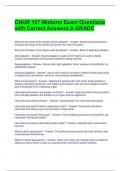Exam (elaborations)
CNUR 107 Midterm Exam Questions with Correct Answers A GRADE
- Course
- Institution
CNUR 107 Midterm Exam Questions with Correct Answers A GRADE What are the dorsa of the hands used to palpate? - Answer- Determining temperature because the dorsa of the hands has thinner skin than the palms What are the base of the fingers used to palpate? - Answer- Best for detecting vib...
[Show more]



